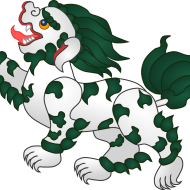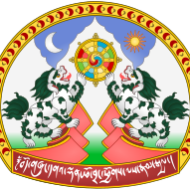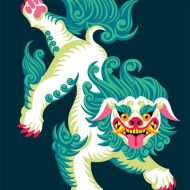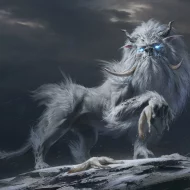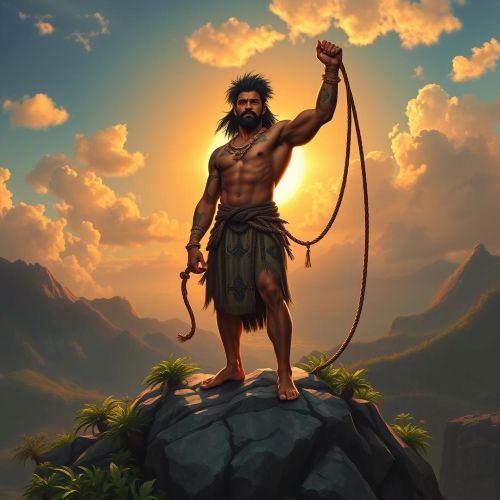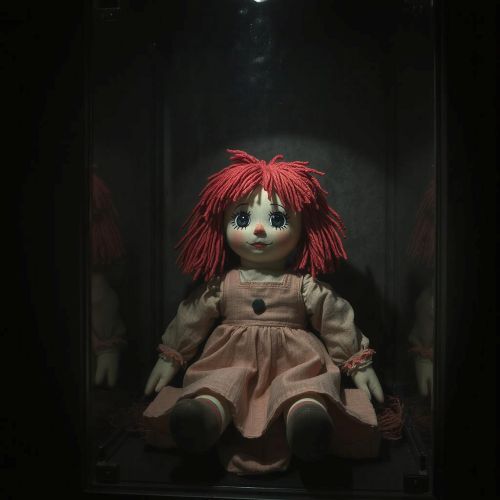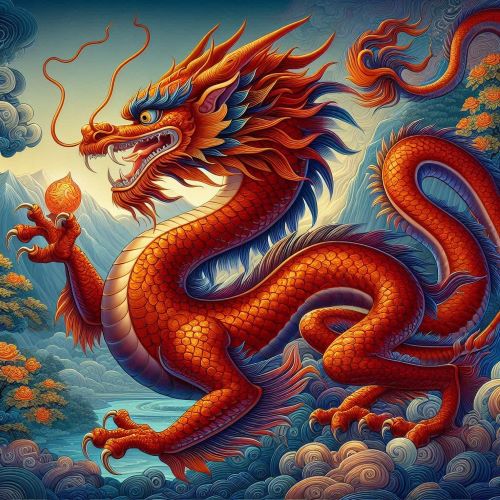Snow Lion : King of Beasts
Listen
At a glance
| Description | |
|---|---|
| Origin | Tibetan Mythology |
| Classification | Animals |
| Family Members | N/A |
| Region | Tibet, China, Bhutan |
| Associated With | Cheerfulness, Fun, Happiness |
Snow Lion
Introduction
The Snow Lions exude youthful energy, featuring a cheerful disposition and a coat of pristine white fur. Within Buddhism, they hold the esteemed role of guardians to Buddhas. In artistic representations like sculptures and paintings, Snow Lions are often portrayed as providing support to the thrones of various Buddhist deities, symbolizing the resilience and bravery inherent in Buddhas.
In the realm of symbolism, the Snow Lion stands as the emblem of Tibet, embodying the essence of its snow-covered mountains and glaciers. Additionally, it serves as a representation of the resilience, bravery, and joy intrinsic to the Tibetan people. Typically depicted as a white lion adorned with a turquoise mane, this creature found its place in the 1592 book “Journey to the West,” where it was featured as a Yokai.
Physical Traits
The Snow Lion boasts a white body complemented by a flowing mane and tail in shades of green or blue. In the realm of Buddhist art, this creature is portrayed as gender-neutral, though some depictions clearly emphasize either a female or male form. When presented in symmetrical pairs, the male is traditionally situated on the right, while the female counterpart occupies the left. Typically, sculptural renditions of Snow Lions are adorned with paint and mounted on metal panels.
In its symbolic abode in the East, the Snow Lion embodies unconditional cheerfulness and a mind devoid of doubt, characterized by clarity and precision. Its beauty and dignity emanate from the harmonious synchronization of body and mind. Infused with a youthful and vibrant energy of goodness, the Snow Lion naturally exudes a sense of delight.
Family
In the realm of Indian art, the lion holds the esteemed title of the king of all animals. In Tibetan artistic traditions, the Snow Lion takes on a symbolic role, representing protection and sovereignty. In the early days of Buddhism, the lion found itself adopted as a symbol of Shakyamuni Buddha. Early paintings illustrate the Buddha seated on a throne, with eight snow lions providing support.
Within sculptures and paintings, the Snow Lion frequently stands as a guardian at the throne of the Buddha, symbolizing strength and courage inherent in the Buddha’s essence. Moreover, it serves as a symbolic conveyance for various Tibetan deities, including Ganapati, Manjushri, Tashi Tserigma, Padmavatha, and Shivashri.
Other names
The Snow Lion is also known as Gang Seng Ge, Xhiu Shi or Rui Shi.
Powers and Abilities
In Tibetan folklore, the milk of the Snow Lion is thought to harbor nutrients that contribute to enhancing the body’s balance and well-being. Additionally, it symbolizes the pristine purity of the Dharma. Despite lacking the ability to fly, the Snow Lion is said to magically produce milk from its paw, possessing healing properties that contribute to bodily well-being and harmony.
Furthermore, the essence of the Snow Lion finds application in various medicinal remedies. The lion’s roar is symbolic of courage and truth, encapsulating a Tibetan expression linked to the Buddha’s teachings on liberation from karma. It was believed that a solitary roar from the Snow Lion had the power to bring down seven dragons from the sky.
Modern Day Influence
Certain dog breeds, including the Tibetan Terrier, Shih Tzu, and Lhasa Apso, have earned the moniker “Lion Dogs” owing to their visual resemblance to lions. Whether these dogs were selectively bred to mirror the Snow Lion or if artistic depictions of the Snow Lion were influenced by their characteristics remains unclear.
The Snow Lion, deemed the king of beasts, is believed to inhabit the highest mountain peaks, towering over creatures in lower elevations. It is also represented as the embodiment of a Tibetan yogi or a hermit. Between 1909 and 1959, a single or a pair of snow lions served as the national emblem of the country. In 1912, the 13th Dalai Lama introduced a new flag featuring two Snow Lions, originally inspired by military banners. This flag is still employed by the government of Tibet in exile but is prohibited in China.
Related Images
Frequently Asked Questions
What is lorem Ipsum?
I am text block. Click edit button to change this text. Lorem ipsum dolor sit amet, consectetur adipiscing elit. Ut elit tellus, luctus nec ullamcorper mattis, pulvinar dapibus leo.
What is lorem Ipsum?
I am text block. Click edit button to change this text. Lorem ipsum dolor sit amet, consectetur adipiscing elit. Ut elit tellus, luctus nec ullamcorper mattis, pulvinar dapibus leo.
What is lorem Ipsum?
I am text block. Click edit button to change this text. Lorem ipsum dolor sit amet, consectetur adipiscing elit. Ut elit tellus, luctus nec ullamcorper mattis, pulvinar dapibus leo.
What is lorem Ipsum?
I am text block. Click edit button to change this text. Lorem ipsum dolor sit amet, consectetur adipiscing elit. Ut elit tellus, luctus nec ullamcorper mattis, pulvinar dapibus leo.
What is lorem Ipsum?
I am text block. Click edit button to change this text. Lorem ipsum dolor sit amet, consectetur adipiscing elit. Ut elit tellus, luctus nec ullamcorper mattis, pulvinar dapibus leo.

